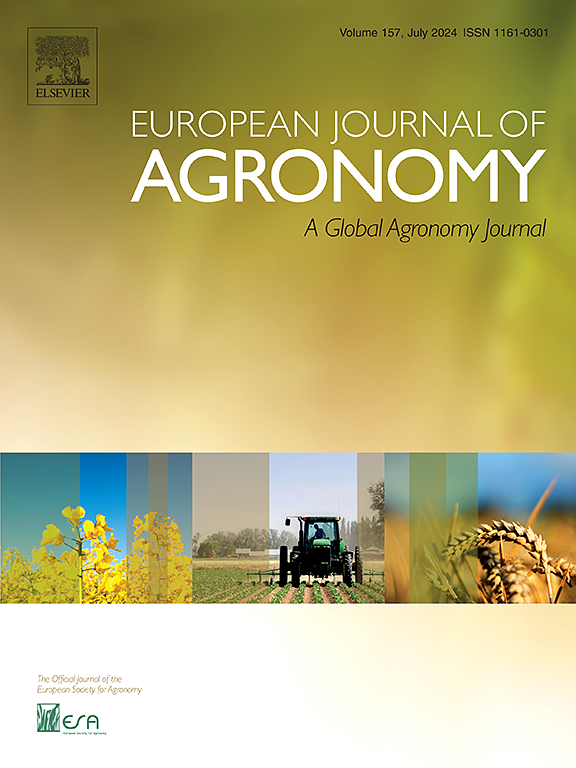Growth conditions but not the variety, affect the yield, seed oil and meal protein of camelina under Mediterranean conditions
IF 5.5
1区 农林科学
Q1 AGRONOMY
引用次数: 0
Abstract
European agriculture policies emphasize the importance of agricultural sustainability, focusing on increase of biodiversity through crop diversification. In Mediterranean dryland cropping systems, the introduction of crops in rotation with cereals is challenged by scarce precipitation and high evapotranspiration. In this scenario, camelina (Camelina sativa (L.) Crantz), a low-input annual oleaginous crop with a high morphological plasticity, short life cycle, and interesting oil and meal composition, could be an option to be included in rotation with winter cereals. The aim of this experiment was to study the agronomic performance, and seed oil and meal protein contents of camelina in two different climatic conditions, with a sowing delay in one of them. Several trials were conducted in Montargull (Mediterranean semihumid) and in Lleida (Mediterranean semiarid) in two seasons (2020–21 and 2021–22). In Montargull, two sowing dates (November, SD1 and January, SD2) were established. In each growing condition, three spring camelina varieties were sown (Calena, CO46 and GP204). Camelina was harvested between May and July, and yield and harvest index were measured. After cold pressing the seeds, seed oil and meal protein contents were analysed. Camelina yield and quality was not related to the variety, but to two climatic scenarios: 1) a favourable rainfall distribution without important drought periods (2020–21); 2) significant rainfalls in November and April, but with a drought period in between (2021–22). In the first situation, camelina production ranged from 1533 to 2187 kg ha−1, with high seed oil (40.4–41.4 %) and meal protein (41.0–44.8 %) contents. In the second situation, the yield decreased to 242–661 kg ha−1, seed oil content to 31.0–34.7 %, and meal protein content to 37.6–40.4 %. Despite these seasonal differences, SD1 in Montargull obtained higher average yields and protein content than in Lleida and in SD2. In contrast, in Lleida and in SD2 in Montargull camelina produced higher oil content. The implementation of camelina into Mediterranean dryland crop rotation systems is feasible. Considering the importance of moisture in these climatic conditions, the use of no-till practices is recommended in dryland fields to avoid excessive water loss, while the use of camelina in irrigated fields could be explored. However, more long-term agronomic and industrial research is still needed.
地中海条件下荠菜的产量、籽油和粕蛋白受生长条件(而非品种)的影响
欧洲农业政策强调农业可持续性的重要性,重点是通过作物多样化来增加生物多样性。在地中海旱地种植系统中,引入与谷物轮作的作物面临着降水稀少和蒸散量大的挑战。在这种情况下,荠菜(Camelina sativa (L.) Crantz)--一种低投入的一年生油料作物,具有形态可塑性强、生命周期短、油脂和粕类成分丰富等特点,可以作为与冬季谷物轮作的一种选择。本试验的目的是研究荠菜在两种不同气候条件下的农艺性能、籽油和粕蛋白含量,其中一种气候条件下荠菜的播种会推迟。在蒙塔古尔(地中海半湿润地区)和莱里达(地中海半干旱地区)分两季(2020-21 年和 2021-22 年)进行了多项试验。在 Montargull,确定了两个播种日期(11 月,SD1;1 月,SD2)。在每种生长条件下,播种三个春季荠菜品种(Calena、CO46 和 GP204)。荠菜在 5 月至 7 月间收获,并测量产量和收获指数。冷榨种子后,分析籽油和粕蛋白含量。荠菜的产量和质量与品种无关,而是与两种气候情景有关:1)降雨分布有利,没有重要的干旱期(2020-21 年);2)11 月和 4 月降雨量大,但中间有干旱期(2021-22 年)。在第一种情况下,荠菜产量为每公顷 1533 至 2187 千克,籽油(40.4-41.4%)和籽粉蛋白(41.0-44.8%)含量较高。在第二种情况下,产量降至 242-661 千克/公顷,籽油含量降至 31.0-34.7%,籽粉蛋白含量降至 37.6-40.4%。尽管存在这些季节性差异,蒙塔尔格尔的 SD1 的平均产量和蛋白质含量仍高于莱里达和 SD2。相比之下,莱里达和蒙塔尔谷 SD2 的荠菜含油量更高。在地中海旱地轮作系统中种植荠菜是可行的。考虑到水分在这些气候条件下的重要性,建议在旱地使用免耕方法,以避免水分过度流失,同时可以探索在灌溉田中使用荠菜。不过,还需要进行更长期的农艺学和工业研究。
本文章由计算机程序翻译,如有差异,请以英文原文为准。
求助全文
约1分钟内获得全文
求助全文
来源期刊

European Journal of Agronomy
农林科学-农艺学
CiteScore
8.30
自引率
7.70%
发文量
187
审稿时长
4.5 months
期刊介绍:
The European Journal of Agronomy, the official journal of the European Society for Agronomy, publishes original research papers reporting experimental and theoretical contributions to field-based agronomy and crop science. The journal will consider research at the field level for agricultural, horticultural and tree crops, that uses comprehensive and explanatory approaches. The EJA covers the following topics:
crop physiology
crop production and management including irrigation, fertilization and soil management
agroclimatology and modelling
plant-soil relationships
crop quality and post-harvest physiology
farming and cropping systems
agroecosystems and the environment
crop-weed interactions and management
organic farming
horticultural crops
papers from the European Society for Agronomy bi-annual meetings
In determining the suitability of submitted articles for publication, particular scrutiny is placed on the degree of novelty and significance of the research and the extent to which it adds to existing knowledge in agronomy.
 求助内容:
求助内容: 应助结果提醒方式:
应助结果提醒方式:


